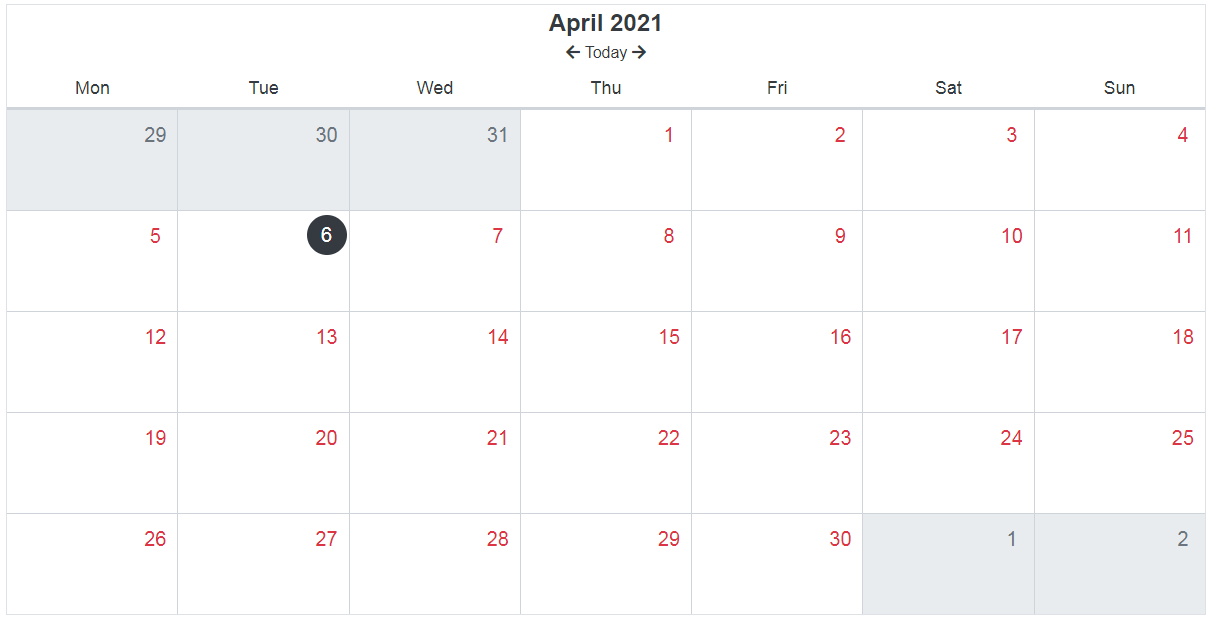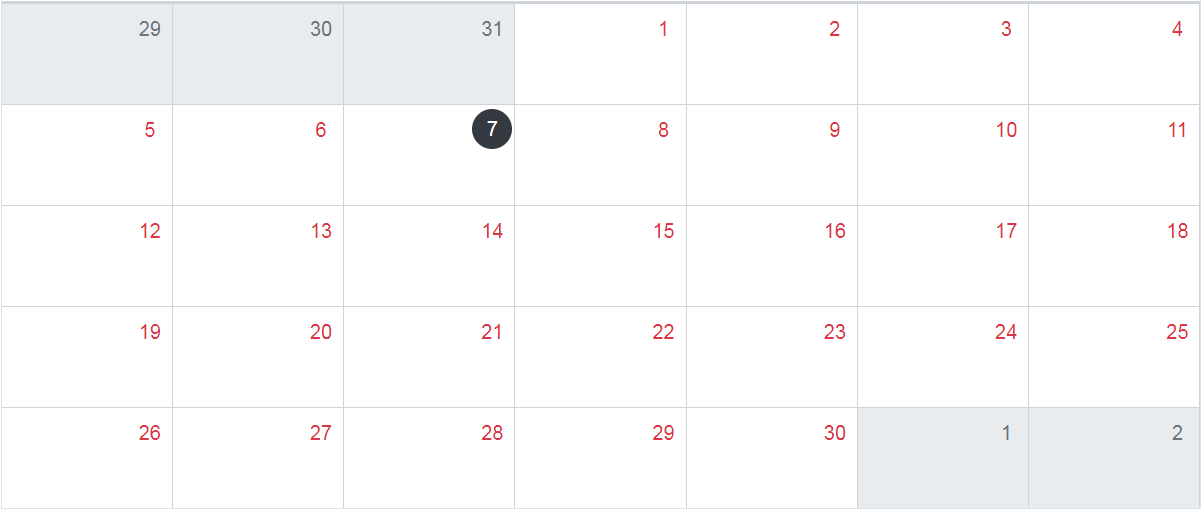前言:
此单元较为複杂,若元件观念较不熟悉的同学,请斟酌观看
这里会运用到props、emit、ES6、day.js
让我们先来观看成品图吧
首先我们将行事曆切分为三个区块製作
分别为:一、header
二、body
三、footer
首先,定义一个父层名为:result的父元件
并在data内定义一个名称,值为day.js
<script> export default { data () { return { selectedDate: dayjs() } } }</script>接着在components创建一个名为pointer的子元件
并定义一个selectedMonth的function,format的输出格式可自订规则
将父层传进的的值「dayjs()」,透过props接收(props可自订验证规则,详请可参考这篇)
并定义验证规则:type必须为「物件型别」、required必须为「true」
这个组件中就完成了表头的年、月份
<template> <div> <div class="XXXXX">{{ selectedMonth }}</div> </div></template><script>export default { props: { selectedDate: { type: Object, required: true } }, computed: { selectedMonth () { return this.selectedDate.format('MMMM YYYY') } }}</script>下个步骤就是要製作切换月份的按钮!
先在父元件创立一个today的function,并定义format的输出格式
today () { console.log(dayjs().format('YYYY-MM-DD')) //string型别 return dayjs().format('YYYY-MM-DD') }创立一个名为dateSelected的子元件将父元件的today及dayjs(),分别透过currentDate、selectedDate传入
接着开始定义上个月、当月、下个月的按钮,写法请参照下方程式码
定义完后使用$emit将newDate的值回传给父元件
<template> <div class="XXXXX"> <div class="YYYYY"> <span @click="selectedPre"><i class="fas fa-arrow-left"></i></span> <span @click="selectedCurrent">Today</span> <span @click="selectedNext"><i class="fas fa-arrow-right"></i></span> </div> </div></template><script>import dayjs from 'dayjs'export default { props: { currentDate: { type: String, required: true }, selectedDate: { type: Object, required: true } }, methods: { selectedPre () { const newDate = dayjs(this.selectedDate).subtract(1, 'month') this.$emit('dateSelected', newDate) }, selectedCurrent () { const newDate = dayjs(this.currentDate) this.$emit('dateSelected', newDate) }, selectedNext () { const newDate = dayjs(this.selectedDate).add(1, 'month') this.$emit('dateSelected', newDate) } }}</script>父元件的code会呈现为:
<template> <div class="XXXXX"> <Pointer :selected-date = "selectedDate"/> <DateSelected :current-date="today" :selected-date="selectedDate" @dateSelected="selDate" /> </div></template><script>export default { data () { return { selectedDate: dayjs() } }, methods: { selDate (newDate) { this.selectedDate = newDate } }, computed: { today () { return dayjs().format('YYYY-MM-DD') }, getMonth () { return dayjs(this.selectedDate).daysInMonth() //取得当月的总天数 }, year () { return Number(this.selectedDate.format('YYYY')) //取得年份 }, month () { return Number(this.selectedDate.format('M')) //取得月份,从 1 开始 }, }}</script>接着第二步骤的body就单纯了许多,因此就不多做解释了,直接附上程式码
<template> <div> <ol class="week"> <li v-for="weekday in weekDates" :key="weekday">{{ weekday }}</li> </ol> </div></template><script>const week = ['Mon', 'Tue', 'Wed', 'Thu', 'Fri', 'Sat', 'Sun']export default { computed: { weekDates () { return week } }}</script>终于完成了header和body的部分,先休息一下喝口水吧!因为複杂的要来了
第三步骤先引入day.js的Weekday插件
Weekday的功能是计算上週,指的是计算出上个礼拜的周一到周日。
当然也可计算本週或是下週,详细说明可参考这篇
import weekday from 'dayjs/plugin/weekday'dayjs.extend(weekday)在这边我们要分别定义三个计算式
一个是当月份,一个是上个月份,另一个是下个月份
今日为2021/04/07,会以今日的日期分别console出结果给大家做写法的比对
首先,定义一个function取得当月份的天数(展开函式写法参考)
currentDays () { return [...Array(this.getMonth)].map((day, index) => { return { date: dayjs(`${this.year}-${this.month}-${index + 1}`).format('YYYY-MM-DD'), isMonth: true } }) }接着,在定义一个function取得下个月份的天数程式码解析:
const nextWeek:
主要是计算每个月的最后一天是星期几。以本月为例,最后一天为星期五
const nextOfmonth:
主要为计算下个月份的1号。以本月为例,下个月的1号为週六,我们的月曆是由週一排序到週日,而本月的最后一天为週五,因此在本月最后一週的週六、週日,就是下个月的1、2号。
const nextMonth:
{ $D:月份里的第一天, $M:月份, $W:下个月的第一天是星期几, $y:年份 }
nextmonthDay () { const nextWeek = this.getWeekday(`${this.year}-${this.month}-${this.currentDays.length}`) console.log('每月的最后一天是星期 :', nextWeek) //每月的最后一天是星期 : 5 const nextMonth = dayjs(`${this.year}-${this.month}`).add(1, 'month') console.log(nextMonth) //注一 const nextOfmonth = nextWeek ? 7 - nextWeek : nextWeek console.log('下个月的可见天数:', nextOfmonth) //下个月的可见天数:2 return [...Array(nextOfmonth)].map((day, index) => { return { date: dayjs(`${nextMonth.year()}-${nextMonth.month() + 1}-${index + 1}`).format('YYYY-MM-DD'), isMonth: false } }) }结束了下个月当然还得做上个月的天数,是不是开始不奈烦了阿~
在定义一个取得上个月份天数的function
这里的做法与上一个差不多,因此就不多做解释了
premonthDate () { const firstWeek = this.getWeekday(this.currentDays[0].date) console.log('每月第一个工作日是星期 :', firstWeek) //每月第一个工作日是星期 : 4 const prevMonth = dayjs(`${this.year}-${this.month}`).subtract(1, 'month') const lastMonth = firstWeek ? firstWeek - 1 : 6 console.log('上个月的可见天数 :', lastMonth) //上个月的可见天数 : 3 const prefirstDay = dayjs(this.currentDays[0].date).subtract(lastMonth, 'day').date() console.log('当月第一个星期一是 :', prefirstDay, '号') //当月第一个星期一是 : 29 号 return [...Array(lastMonth)].map((day, index) => { return { date: dayjs(`${prevMonth.year()}-${prevMonth.month() + 1}-${prefirstDay + index}`).format('YYYY-MM-DD'), isMonth: false } }) }附上父组件的最终程式码给大家参考
<template> <div> <div class="xxxxxx"> <div class="yyyyyy"> <Pointer :selected-date = "selectedDate" /> <DateSelected :current-date="today" :selected-date="selectedDate" @dateSelected="selDate" /> </div> <WeekDate/> <ol class="zzzzzz"> <MonthDate v-for="day in days" :key="day.date" :day="day" :is-today="day.date === today" /> </ol> </div> </div></template><script>import weekday from 'dayjs/plugin/weekday'dayjs.extend(weekday)export default { data () { return { selectedDate: dayjs() } }, methods: { getWeekday (date) { return dayjs(date).weekday() }, selDate (newDate) { this.selectedDate = newDate } }, computed: { today () { return dayjs().format('YYYY-MM-DD') }, getMonth () { return dayjs(this.selectedDate).daysInMonth() }, year () { return Number(this.selectedDate.format('YYYY')) }, month () { return Number(this.selectedDate.format('M')) }, currentDays () { return [...Array(this.getMonth)].map((day, index) => { return { date: dayjs(`${this.year}-${this.month}-${index + 1}`).format('YYYY-MM-DD'), isMonth: true } }) }, nextmonthDay () { const nextWeek = this.getWeekday(`${this.year}-${this.month}-${this.currentDays.length}`) const nextMonth = dayjs(`${this.year}-${this.month}`).add(1, 'month') const nextOfmonth = nextWeek ? 7 - nextWeek : nextWeek return [...Array(nextOfmonth)].map((day, index) => { return { date: dayjs(`${nextMonth.year()}-${nextMonth.month() + 1}-${index + 1}`).format('YYYY-MM-DD'), isMonth: false } }) }, premonthDate () { const firstWeek = this.getWeekday(this.currentDays[0].date) const prevMonth = dayjs(`${this.year}-${this.month}`).subtract(1, 'month') const lastMonth = firstWeek ? firstWeek - 1 : 6 const prefirstDay = dayjs(this.currentDays[0].date).subtract(lastMonth, 'day').date() return [...Array(lastMonth)].map((day, index) => { return { date: dayjs(`${prevMonth.year()}-${prevMonth.month() + 1}-${prefirstDay + index}`).format('YYYY-MM-DD'), isMonth: false } }) }, days () { return [ ...this.premonthDate, ...this.currentDays, ...this.nextmonthDay ] } },最后我们要将非本月的日期以及当天的日期赋予颜色以便区隔
因此再新增一个子组件,名为monthDate,透过props将v-for的day值传入即可
<template> <div> <li class="XXXXXX" :class="{'current': !day.isMonth, 'today': isToday}"> <span>{{ isTag }}</span> </li> </div></template><script>export default { props: { day: { type: Object, required: true }, isMonth: { type: Boolean, default: false }, isToday: { type: Boolean, default: false } }, computed: { isTag () { return dayjs(this.day.date).format('D') } }}</script>若有错误的地方欢迎批评指教 谢谢

 微信扫一扫打赏
微信扫一扫打赏
 支付宝扫一扫打赏
支付宝扫一扫打赏


